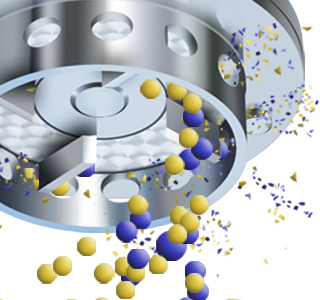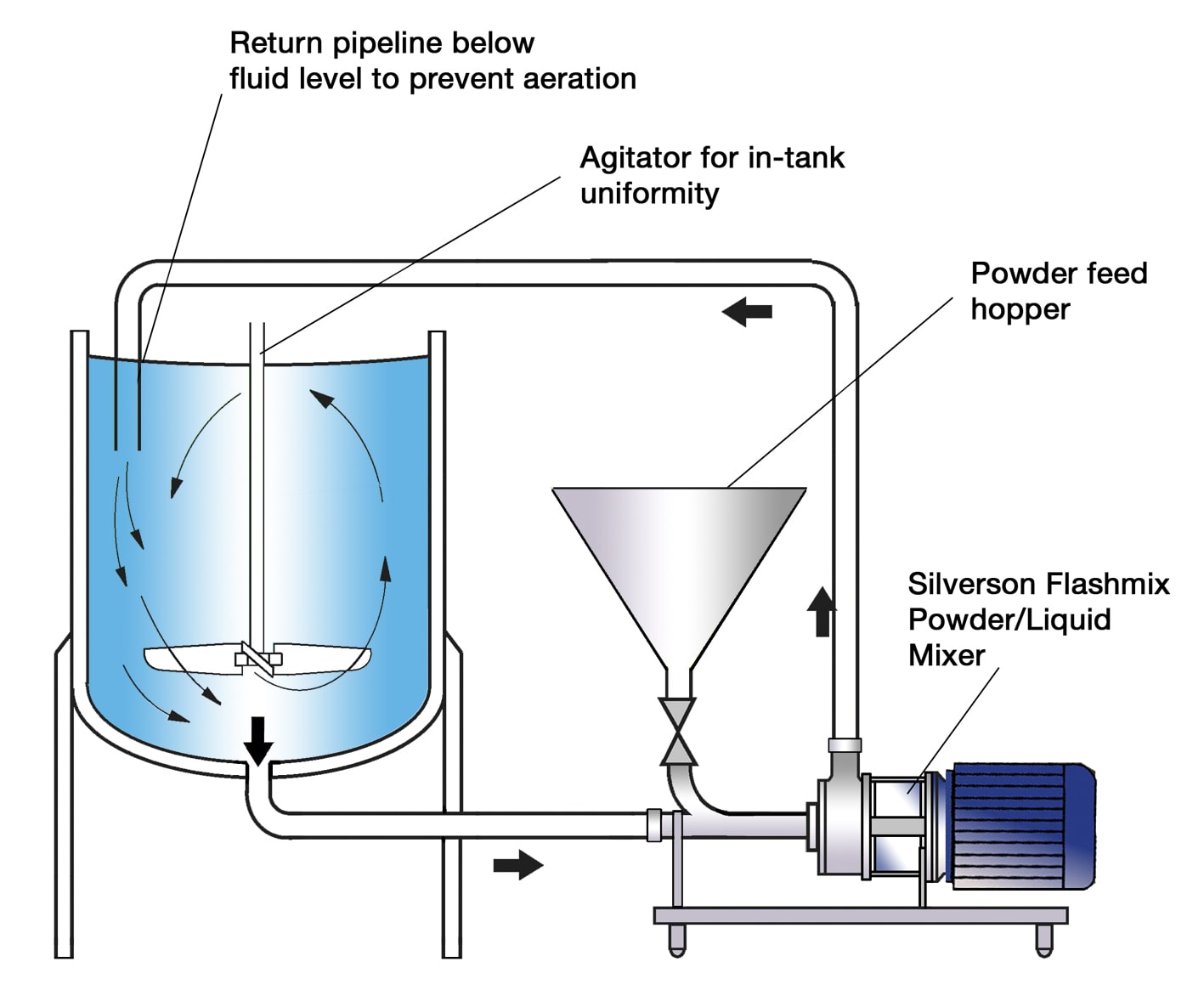Preparation of Ice Cream Mixes
Ice cream mixes are formulated from either whole milk, skim milk, cream or in some cases water, with a number of added ingredients.
The Process
A typical mix would be prepared in the following manner:
- Liquid ingredients are weighed/metered into the process vessel. Heating follows to aid melting of the fat and dissolving/hydration of subsequent ingredients.
- Powdered ingredients - skim milk powder, sugars, whey powder, etc. are added to the liquid and mixed until dispersed.
- Stabilizing and emulsifying agents are added. These may be dry premixed with other ingredients, (e.g. sugar) to reduce particle agglomeration and “weight” the powder to aid incorporation into the liquid.
- Fat is added. Butter or other solid fats may be melted in a separate vessel before addition to the mix.
- The mix is pasteurized at around 185ºF (85ºC).
- The mix is homogenized, usually by passing through a high pressure homogenizer.
- The product is then “aged” in a holding (or ripening) tank to allow the stabilizing agents to hydrate and the fat to crystallize.
- Flavor and coloring may be added at this stage.
- The finished mix is frozen in special freezers which whip a controlled amount of air into the mix.
In many countries, legislation covers the composition and labelling of products. These regulations restrict the use of certain ingredients and specify minimum content of the fat and total solids.
Ingredient |
Typical % |
Function |
Source |
|---|---|---|---|
| Fat | 5 - 12 | Contributes to the richness of the flavor, and the texture (or mouthfeel) of the product. | Whole milk, cream, butter or butter oil. Where permitted non-milk fats such as palm oil, palm kernel oil and coconut oil are used. These are generally hydrogenated to obtain the desired melting point. |
| Milk Solids Not Fat (MSNF) |
5 - 12 | Adds to the body, smoothness and texture of the ice cream. | Proteins, lactose and mineral salts present in milk. The MSNF content is supplemented by adding skim milk powder, or, where permitted, whey powder or “Skim milk replacer.” |
| Sugar | 10 - 20 | In addition to sweetening the product, sugars are also used to adjust the solids content to provide "body," and to control the melting point and crystallization of the product. | Sucrose, dextrose, fructose, glucose, lactose and invert sugar are used, both in granular and syrup forms. |
| Stabilizer | 0.3 - 0.5 | See separate report. | |
| Emulsifier | 0.3 - 0.5 | See separate report. | |
| Flavor | 0.2 - 0.4 | The use of flavorings is controlled by legislation in many countries. Both natural and synthetic flavors are used. | Most commonly vanilla, in the form of an extract in alcohol. Other flavors, such as fruit extracts, nuts and toffee are common. Cocoa is used in chocolate (and chocolate flavor) ice creams. |
| Coloring | 0.01 - 0.02 | Also subject to legislation, colorings are used in the form of powder or paste. | e.g. Annatto, Beta Carotene, Curcumin, etc. |
The Problem
Mixing powders into liquids is one of the most difficult mixing operations. The process is subject to a number of problems when using conventional powder/liquid wetting systems and agitators:
- Powder must be added at a controlled rate to reduce agglomeration of particles.
- Premixing of powders increases labor costs and process time.
- SMP, whey powder and cocoa powder (used in chocolate ice creams) are very cohesive, making handling and controlled powder addition difficult.
- Stabilizing and emulsifying agents have an even greater tendency to agglomerate and require special handling.
- Conventional systems do not produce sufficient shear to break down agglomerates.
- Long processing times are required to complete dispersion and achieve a satisfactory consistency.
- Cocoa (where used) needs to be thoroughly wetted and “cooked” to prevent it imparting a “gritty” or “floury” texture to the ice cream.
The Solution
The above problems can be overcome by using a Silverson High Shear Mixer. Operation is as follows:

Stage 1
The high speed rotation of the rotor blades creates a powerful suction which draws the liquid and solid/powdered ingredients into the workhead. These can be added without the need for pre-mixing.

Stage 2
The materials are subjected to intense shear in the confined area of the workhead. Agglomerates are broken down in the gap between the rotor blades and stator wall.

Stage 3
A lump-free mixture is rapidly obtained. The product is forced out of the stator as fresh material is drawn into the workhead. A circulatory mixing cycle develops in which all the material passes through the Silverson workhead.
-
Stage 1

Stage 1
The high speed rotation of the rotor blades creates a powerful suction which draws the liquid and solid/powdered ingredients into the workhead. These can be added without the need for pre-mixing.
-
Stage 2

Stage 2
The materials are subjected to intense shear in the confined area of the workhead. Agglomerates are broken down in the gap between the rotor blades and stator wall.
-
Stage 3

Stage 3
A lump-free mixture is rapidly obtained. The product is forced out of the stator as fresh material is drawn into the workhead. A circulatory mixing cycle develops in which all the material passes through the Silverson workhead.
The Advantages
- Premixing of powdered ingredients is not necessary.
- Agglomerate-free mix.
- Stable emulsion.
- Rapid mixing times.
- Maximized yield of raw materials as thickening agents are fully hydrated and other ingredients are properly dispersed.
The batch size, formulation, type of ingredients and the viscosity of the mix dictates which machine from the Silverson product line is suited to individual processing requirements:
Silverson Flashmix
- Ideal for larger batches
- Capable of rapidly incorporating large volumes of powders
- Minimized aeration
- Minimized cleaning requirements
- Suitable for higher viscosity mixes
- Suitable for operation at higher temperatures
- Minimum operator input required
High Shear In-Line Mixers
- Ideal for larger batches
- Easily retrofitted to existing plant
- Must be used in conjunction with an efficient in-tank agitator to wet out powder
- Aeration free
- Self-pumping
- Can be used to discharge vessel
- Ultra Sanitary models available
- High Viscosity models available
High Shear Batch Mixers
- Suitable for batches up to 300 US gallons
- Can be used on mobile floor stands
- Can easily be moved from vessel to vessel
Silverson Ultramix
- Excellent in-tank movement
- Capable of rapidly incorporating large volumes of powders
- Ultra Sanitary CIP design
- Ideal for higher viscosity mixes
- Low maintenance



